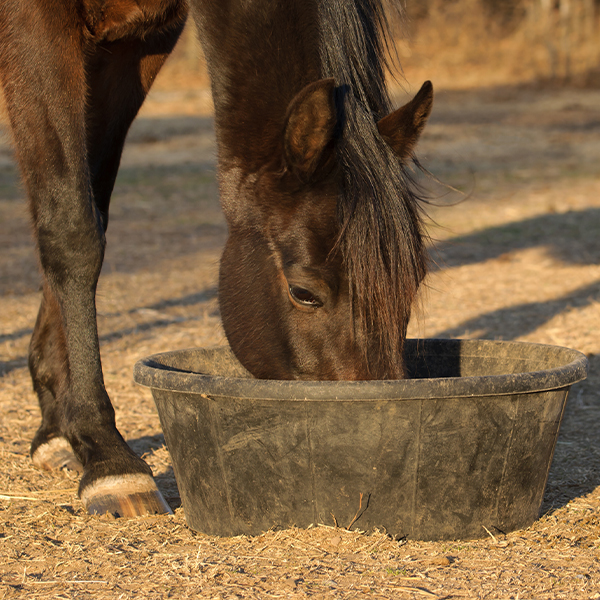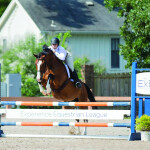It’s the most wonderful time of the year for performance horse owners: show season! This time of the year brings a mixture of emotions, and in the center of all this are the horses. Horses and riders have been practicing and conditioning over the winter months for peak performance so they can bring home some accolades.
Just like the physical training to bring horses up to peak athletic performance is significant, the diet and nutrition that helps fuel your horses’ performance are equally important.
Feeding the Equine Athlete
Similar to human athletes when they increase exercise, horses will also need more “groceries” to their diet to supplement the additional energy output and to increase muscle mass. Without proper nutrition, the equine athlete will most likely not develop the athletic physique needed for high performance and exhaust themselves sooner during performance.
Besides workload, owners also need to take into consideration their horse’s age, discipline, breed, training schedule, travel schedule and health history. Nutrition should not only support muscle development but also gut health, respiratory health, post-workout recovery, immunity and electrolyte balance. All these factors need to be evaluated when owners are developing the best possible nutrition plan.
Owners should also maintain an optimal body condition score (fat coverage) since too much or too little fat can negatively affect performance. Ideally, peak performance horses should have a body condition score (BCS) of about 4.5-5 on the 9-point Henneke scoring system. To check your horse’s body condition score, fat coverage should be evaluated on the following parts of the horse’s body:
- Crest of the Neck
- Withers
- Ribs
- Tailhead
- Along the spine (loin area)
- Behind the elbow
Score each area then average the score. Anything below 4.5 for a peak performance horse is considered too lean which means the horse will have less energy reserves available.
Gym Time: What Level of Workload Your Horse is at?
Nutritional requirements for horses depend heavily on your horse’s workload. There are five levels of exercise established by the National Research Council (NRC):
- Maintenance: horses NOT engaged in any exercise program.
- Light Exercise: 1-3 hours per week; 40% walk, 50% trot, 10% canter. Heart rate during work is approximately 80 beats per minute.
- Moderate Exercise: 3-5 hours per week; 30% walk, 55% trot, 10% canter, 5% low jumping, cutting, other skill work. Heart rate during work is approximately 90 beats per minute.
- Heavy Exercise: 4-5 hours per week; 20% walk, 50% trot, 15% canter, 15% gallop, jumping, other skill work. Heart rate during work is approximately 110 beats per minute.
- Very Heavy Exercise: various; ranges from 1 hour per week speed work to 6-12 hours per week slow work. Heart rate during work is about 110-150 beats per minute.
Heart rate is another main factor to consider when determining nutritional requirements, as it determines caloric energy the horse is using during work. Several other factors can also determine caloric needs such as:
- Level of fitness and skill
- Speed
- Breed
- Weight of horse, tack and rider
- Weight being pulled
- Footing
- Temperature
Nutritional Requirement by Exercise
Level:
There are multiple aspects of nutrition that will be affected when a horse undergoes an exercise lifestyle change. These aspects
include:
- Digestible Energy: energy available for digestion and absorption after fecal losses. Expressed as megacalories (mcal) per kg of body weight.
- Protein: required to build and maintain larger muscle mass, support muscle repair and replace nitrogen losses in sweat. Expressed as grams/day.
- Amino Acids: building blocks of protein. Most critical are the essential amino acids since they cannot be made within the body. Expressed as grams/day
- Vitamins and Minerals: important for energy metabolism, immunity support, fluid balance, bone density, nerve impulses. Expressed as mg or IU.
It is recommended that horses receive at least 1% of body weight in high quality forages if at maintenance level, while horses in heavier exercising need to receive close to 1.75%. For horses needing grain, expect to feed about 0.5% of body weight per day for horses at maintenance, while heavier worked horses will be close to 1% of body weight per day.
Final Takeaways
To summarize feeding the equine athlete, there is no one way to do it correctly. Tons of factors go into developing the best diet to meet your athlete’s needs. Consult with your equine nutritionist and veterinarian about your horse’s lifestyle and how you can best meet your horse’s needs this show season with nutrition.
For more detailed information about feeding the equine athlete, please visit the following website courtesy of Mad Barn:










